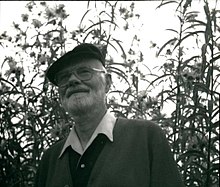Charles Bixler Hoarse
Charles Bixler Heiser (born October 5, 1920 in Cynthiana (Indiana) , USA ; † June 11, 2010 ) was an American botanist . Its official botanical author abbreviation is " Heiser ".
Life
Charles Bixler Heiser was born on October 5, 1920, the son of an insurance employee. As a child, he often visited his grandparents' farm, which gave him a great deal of interest in plant breeding. During his childhood, his parents often moved within southern Indiana until they eventually settled in Belleville, Illinois , where he graduated from high school . At the beginning of his studies at Washington University in St. Louis, Missouri , his goal was initially a degree in journalism, but he graduated with a degree in English and botany. During his studies, he was primarily concerned with sunflowers, but he wrote his master's thesis on the genus Psilostrophe (Asteraceae). In the course of his studies he also met his future wife Dorothy Gaebler when both of them were the only two listeners of Edgar Anderson's taxonomy lecture due to the war years . Both married in 1944 and had three children together.
After graduation, Heiser initially stayed at Washington University for a short time, but in 1945, on the advice of Edgar Anderson and Robert Everard Woodson, moved to the University of California at Berkeley , where he worked under George Ledyard Stebbins . He stayed in contact with Anderson during the time and completed his doctoral thesis on the genus of sunflowers ( Helianthus ) until 1947 . This group of plants remained an important topic even after completing his time as a doctoral student, and the last publication before his death dealt with this genus.
Although he was offered a postdoctoral position at the University of California , he moved to Indiana University in 1947 , suspecting that botany would have a bright future at that university under the direction of Ralph E. Cleland . Initially employed as an assistant professor, he became a Distinguished Professor in 1979 and, from 1986, an Emeritus Professor at the university. During his time at the university, he also developed a keen interest in the flora of tropical America. Among other things, this led to the fact that he dealt with the genus of the peppers ( Capsicum ) and also researched the origin and relationship of the Lulo ( Solanum quitoense ), an Ecuadorian fruit. He fundamentally revised the taxonomy of the cultivated Capsicum , so that the previously 50 species were reduced to only five species. This work formed the basis for further taxonomic research into the genus; the five species he recognized are still recognized today.
Heiser died on June 11, 2010 of complications from a stroke he had suffered 18 months earlier.
Awards, titles and offices
- 1967: President of the American Society of Plant Taxonomy
- 1969: Gleason Award from the New York Botanical Garden
- 1972: Merit Award from the Botanical Society of America
- 1974: President of the Society for the Study of Evolution
- 1978: Founder and President of the Society for Economic Botany
- 1980: President of the Botanical Society of America
- 1984: Distinguished Economic Botanist Award from the Society for Economic Botany
- 1985: Pustovoit Award from the International Sunflower Association
- 1987: Member of the US National Academy of Sciences
- 1988: Asa Gray Award from the American Society of Plant Taxonomists
- 1996: Honorary member of the Instituto de Ciencias Naturales in Ecuador
- 1997: Distinguished Scholar Award from the New York Botanical Garden
- 2002: Raven Outreach Award from the American Society of Plant Taxonomists
- 2004: Garden Globe Award for the book "Weeds in my Garden" (2003)
- 2007: Centennial Award from the Botanical Society of America
supporting documents
- Barbara Pickersgill and Gregory J. Anderson: Travels with Charley — sunflowers and beyond: an appreciation of the life and work of Charles B. Heiser, Jr. (1920-2010) . In: Economic Botany , Volume 64, Number 4, 2010. pp. 281-286, doi : 10.1007 / s12231-010-9131-2
Web links
- Author entry and list of the described plant names for Charles Bixler Heiser at the IPNI
| personal data | |
|---|---|
| SURNAME | Hoarse, Charles Bixler |
| ALTERNATIVE NAMES | Hoarse, Charley |
| BRIEF DESCRIPTION | American botanist |
| DATE OF BIRTH | October 5, 1920 |
| PLACE OF BIRTH | Cynthiana (Indiana) , USA |
| DATE OF DEATH | June 11, 2010 |
